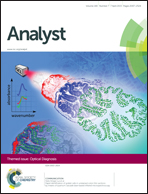Tissue phantoms to compare spatial and temporal offset modes of deep Raman spectroscopy
Abstract
Time-resolved and spatially offset Raman spectroscopies have previously been demonstrated for depth analysis through strongly scattering, non-transparent materials. In this study, several series of tissue phantoms were created with varied compositions and thicknesses to compare the potential of these different Raman techniques for biomedical applications. Polydimethylsiloxane (PDMS) phantoms were made with TiO2 particles suspended as a scattering agent, mimicking the scattering properties of biological tissues. The phantom layers contained embedded biomineral simulating inclusions (sphere or layer-shaped) with varied carbonate to phosphate ratios. The tissue phantoms were studied using Time Resolved Raman Spectroscopy (TRRS), Spatially Offset Raman Spectroscopy (SORS), and their combination, using a single instrumental setup with picosecond pulsed excitation at 720 nm and two different detectors. A comparison is made of the efficiency of these techniques to resolve chemical information from these heterogeneous scattering phantom samples. Measurements with continuous wave detection were found to offer a better signal-to-noise ratio than with TRRS, and in SORS measurements ratios of target to matrix signal were found to vary depending on the structural geometry and optical properties of the phantoms. Anomalous SORS behaviour, in which the relative contribution from the target decreases with offset, was observed in cases where the target was highly scattering and the top layer was relatively transparent. Time gating with an intensified charge-coupled device (ICCD) detector can yield more direct information on the depth of the hidden material.

- This article is part of the themed collection: Optical Diagnosis (2014)

 Please wait while we load your content...
Please wait while we load your content...